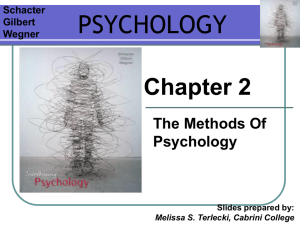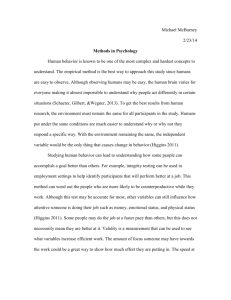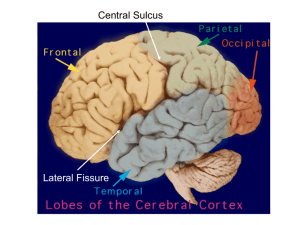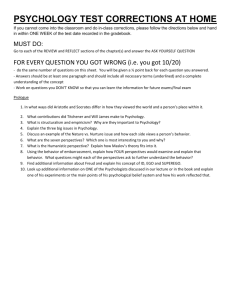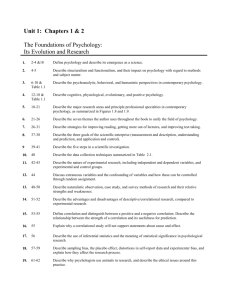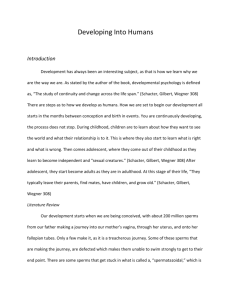Methods of Psychology
advertisement
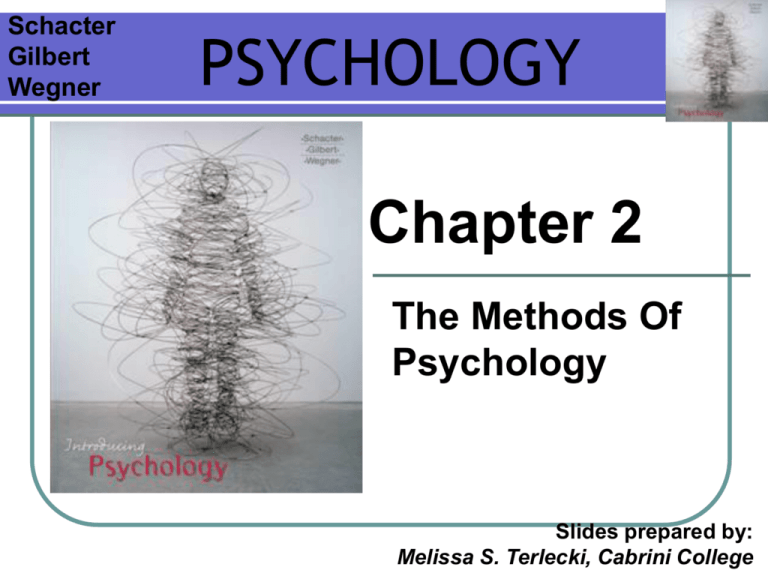
Schacter Gilbert Wegner PSYCHOLOGY Chapter 2 The Methods Of Psychology Slides prepared by: Melissa S. Terlecki, Cabrini College Schacter Gilbert Wegner PSYCHOLOGY 2.1 Empiricism: How to Know Things Schacter Gilbert Wegner PSYCHOLOGY 2.2 The Science of Observation: Saying What Empiricism involves using observation to gain knowledge about the world. Because causal observation is prone to error, sciences have developed methods for observation. Method: a set of rules and techniques for observation. Questions Why is it so hard to study people scientifically? Empiricism: How to Know Things Three things that make people especially difficult to study: Complexity Variability Reactivity Observe: use your senses to learn about something’s properties. Measurement Measure: a device that can detect the measurable events to which an operational definition refers. Operational definition: a description of an abstract property in measurable terms. For example Try to give a definition of ‘length’ Length: the change in the location of light over time. So… ‘A bookshelf is a meter in length’: We are saying how long it takes a particle of light to travel from one end of the shelf to the other. Question: How could you measure happiness? Figure 2.1: Sources of Invalidity (p. 36) Measurement Prerequisites for accurate measurement: validity: the characteristic of an observation that allows one to draw accurate inferences from it. reliability: the tendency for a measure to produce the same result whenever it is used to measure the same thing. power: the tendency for a measure to produce different results when it is used to measure different things. Same Question: How would you measure happiness? Another Question (sorry) How do you know what to measure with so your test will be reliable? Samples Case method: a method of gathering scientific knowledge by studying a single individual. Population: the complete collection of participants who might possibly be measured. sample: the partial collection of people who actually were measured in a study. Question: Why do people act differently when they know they’re being observed? Demand Characteristics Demand characteristics: those aspects of an observational setting that cause people to behave as they think an observer wants or expects them to behave. Naturalistic observation: a method of gathering scientific knowledge by unobtrusively observing people in their natural environments. New York City Bar’s One-way Mirror Demand Characteristics Naturalistic observation cannot solve the problem of demand characteristics. Some events cannot be observed naturally. Some observations can only be gathered through direct interaction. Private or anonymous responding, measuring behaviors not susceptible to demand, and blind procedures can minimize demand characteristics. cover stories. filler items. Questions Why is it sometimes important that participants not be aware of an experiment’s true purpose? Expectations can influence observations. Expectations can influence reality. OK, we have our reliable measurement and constructed a representative sample. Now, how do we apply that measurement to the sample in the most accurate way possible? The Blind Observer Double-blind observation: an observation whose true purpose is hidden from the researchers as well as from the participant. Schacter Gilbert Wegner PSYCHOLOGY 2.3 The Science of Explanation: Saying Why Quick Review : So, empiricism is studying the world around us, using our 5_________ through ____________. But, our senses sometimes let us down, so we’ve come up with a _____________ (a set of rules and techniques for observation) to gather information. So, empiricism is studying the world around us, using our 5 SENSES through OBSERVATION. But, our senses sometimes let us down, so we’ve come up with a METHOD (a set of rules and techniques for observation) to gather information. Next, we define what we are trying to measure and select a _____________(a partial collection of objects of events that is measured) to do a test. Next, we define what we are trying to measure and select a SAMPLE (a partial collection of objects of events that is measured) to do a test. Unfortunately, some people act differently when they are being watched ( _________-characteristic), so psychologists employ _____________-observation and double-________observation to affectively gather information. Unfortunately, some people act differently when they are being watched ( DEMAND-characteristic), so psychologists employ NATURALISTIC-observation and double-BLIND observation to affectively gather information. What if we wanted to study the relationship between the amount of violence a child watches on TV and the aggressiveness of the child’s behavior? Questions Televised violence and aggression are correlated. Does that mean televised violence causes aggressiveness? Correlation and Causation Correlation: the “co-relationship” between two variables Variable: a property whose value can vary or change. (TV & Aggression) Third-variable correlation: the fact that two variables may be correlated only because they are both caused by a third variable. (Lack of Adult Supervision) Figure 2.2: Causes of Correlation (p. 42) But, there is a problem… Cannot dismiss all potential third variables. third-variable problem: the fact that the causal relationship between two variables cannot be inferred from the correlation between them because of the ever-present possibility of third-variable correlation. So… Experiment: a technique for establishing the causal relationship between variables, through manipulation Experiments always involve manipulation The variable that is manipulated in an experiment is called the: independent variable: Which leads to two groups: experimental group: exposed to the stimulus being studied. control group: not exposed to the stimulus being studied. dependent variable: the variable that is measured in a study (Aggression) Figure 2.3: Manipulation (p. 45) Questions In what ways do we perform experiments in everyday life? Drawing Conclusions Internal validity: the characteristic of an experiment that allows one to draw accurate inferences about the causal relationship between an independent and dependent variable. An independent variable has been effectively manipulated. A dependent variable has been measured in an unbiased way with a valid, powerful, and reliable measure. A correlation has been observed between the independent and the dependent variable. Theory: a hypothetical account of how and why a phenomenon occurs Hypothesis: a specific and testable prediction made by a theory (If this…, then…) Drawing Conclusions External validity: clearly defining the independent (TV watching) and dependent (Aggression) variables Schacter Gilbert Wegner PSYCHOLOGY 2.4 The Ethics of Science: Saying Please and Thank You The Ethics of Science: Saying Please and Thank You Code of ethics (APA, 1958): informed consent: a written agreement to participate in a study made by a person (adult) who has been informed of all the risks that participation may entail. freedom from coercion. protection from harm. risk-benefit analysis. debriefing: a verbal description of the true nature and purpose of a study that psychologists provide to people after they have participated in the study. The Ethics of Science: Saying Please and Thank You Institutional Review Board (IRB) approval required. Non-human psychological research performed. ethical treatment and rights. costs versus benefits. moral dilemma. PeTA and the Unethical Treatment of Animals (p. 50) Questions Is it ever justifiable to harm a human or nonhuman research participant? Where Do You Stand? The Morality of Immoral Experiments Nazi doctors during World War II unethically experimented on prisoners. Controversial publication of data results.
